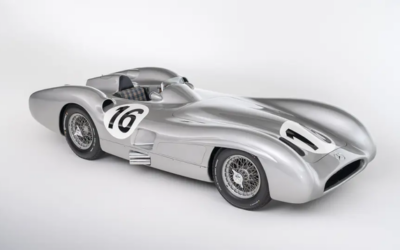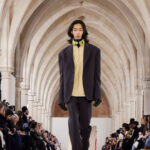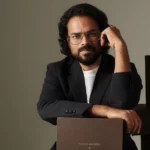The Eric Musgrave Interview: Why Strathberry founders have bags of confidence

The woes affecting much of the luxury and premium accessory sector have bypassed fast-growing Scottish brand Strathberry, which has seen sales leap by 40% in the past year to reach £40m. The target now is to reach £100m over the next three years.
Started in Edinburgh in 2013 by Leeanne and Guy Hundleby, who had no experience of the leathergoods world, the handbag-driven brand has shown that having attractive styles in high-quality manufacture at relatively accessible prices is a potent formula at home and abroad.
In the latest interview by our contributor Eric Musgrave, conducted at Strathberry’s elegant townhouse HQ in central Edinburgh, the husband and wife team explain their passion for their creation, discuss why they make all their bags in Spain, and reveal why they might again be stressing more obviously their Scottish roots.
Displaying the couple’s entrepreneurial zeal, the rise and rise of Strathberry has been funded by a Kickstarter campaign in 2015, which raised £122,000, followed in 2021 by an £8m injection from British private equity group BGF, which received in turn 25% of the company and seats on the board.
Strathberry Burlington Arcade, London
Strathberry is sold through the company’s own stores, from its website and via selected wholesale customers across major international markets.
In November, Martin Byrne, former chief commercial officer of admired British jewellery brand Monica Vinader, will join Strathberry as its first managing director, allowing Guy and Leeanne to focus on product development, global expansion and reaching that £100m target.
Having met at some friends’ wedding in Ireland in 1997 (she knew the bride, he knew the groom), the pair married in 2003 and have four children – girls aged 19 and 12, and boys of 17 and 15. Before Strathberry, Ulster-born Leeanne had a career in HR with major companies like Scottish Power and Royal Bank of Scotland, while Guy, who describes himself as “Anglo-Scottish from Edinburgh”, had a CV that included bike courier, barman and ski guide. More usefully, immediately before Strathberry he was a partner in a company that supplied ethically-sourced products, including T-shirts and non-textiles goods, to UK charities. Their significant change of direction into sophisticated leathergoods prompted the first question:
Why did you start a handbag business when that sector is already so crowded?
Guy: We both had a creative leaning before we started Strathberry, but our jobs didn’t enable us to have an outlet for it. We built our own very modern house on the south of Edinburgh, and very much liked all the creative aspects of that. So it was really nice to do something which enabled us to connect with our creativity.
Leeanne: There was not a conscious decision that it had to be handbags. We had a desire to create a luxury global brand from Scotland and a handbag is a product every female in the world has. Women are constantly looking for the right handbag, whether it’s the evening handbag, the working handbag, the casual Saturday afternoon handbag, There’s always a need for a handbag.
When we visited the village of Ubrique in southern Spain and we saw all the leathers, how beautiful they were – the smell, the touch, the feel – we knew we could make beautiful handbags as well.
Also, having our own business gave us flexibility around the kids, so we could attend a rugby match on a Wednesday or go and watch a swimming gala if we wanted. It’s lovely to be able to work for yourself.
As your informative website explains, Ubrique in Andalucia is renowned for its leather craftsmen and is used by most of the world’s top accessory brands. All your bags are made there. But wouldn’t you have preferred to make in Scotland or elsewhere the UK?
Guy: We did look around and tried a few UK-made products but there’s no one here who can do what we want in a scalable way. I made a few trips to (traditional leathergoods area) Walsall and met some really nice brands. But they tend to have a different construction to the kind we were after, which is a bit softer, a bit less equestrian. Similarly, we looked at some makers in Scotland who are very good at some things, and probably make a bag that lasts 1,000 years, but they don’t have some of the aspects we were after. In Ubrique, we make our bags alongside the world’s top luxury names.
You are much admired as a “Scottish” success story, especially in Scotland, but your aesthetic is much less “Scottish” now than it was when you started as Strathberry of Scotland in 2012 with Clare Robertson as your designer. The original look changed after 2014 when she left. Then you dropped the “of Scotland” from your name after your Kickstarter campaign. So how “Scottish” is Strathberry?
Leeanne: We are very proud of what we have achieved being from Edinburgh. Maybe we regret dropping the “of Scotland” but when we did it in around 2014 it was because it felt our brand name wasn’t global enough. Strathberry by itself felt very strong and significant. When Guy and I started designing the range we became more minimalist and international, but we now have started relooking at our Scottish aesthetic.
Currently we are working with some of the most renowned Scottish mills to develop our own tartan or house check. Our two main designers today are talented Italians – one is ex-Burberry and the other ex-Marni – and they see “Scottish” things differently to us. There could be little places we play with obviously Scottish elements, such as in our packaging.
Strathberry Nano Tote with signature “bar handle”
Where did your signature metal “bar handle” come from?
Leeanne: It was from a folio sheet music bag we found in the attic of Guy’s family home. Actually, my first-ever work bag had the same type of handle, so it’s not unusual on briefcases, but we wanted to reimagine it for handbags. We wanted a modern structural, architectural kind of shape to complement our designs and it worked.
Guy: Still one of our best-sellers is our Vanilla Tote, which Leanne and I created by cutting out paper maquettes on our kitchen table. I took them to Spain to the workshops and worked with them to create the design. The bar handle made it a lovely bag and we saw we could scale it up or down on different styles but keep the same hardware.
How do you two divide responsibilities, and why have you hired Martin Byrne as your first MD?
Leeanne: On a Venn diagram we would overlap on the creative side, which is our greatest love. If we don’t have good handbags, we’ve not got a business. The best time of our week is sitting down with our design team and looking at what’s coming up – seasonal colours, new silhouettes, fabrications that we want to test and try. After that, we divide and conquer. Guy is very embedded within our wholesale, while I look after retail, so we have a channel each. Then we’ve got quite a big online team and we’re both a bit involved in that.
Guy: Leanne is more involved in the organisational aspects of the business, the people, the brand. I’m more involved in the product, the actual making. I spend a lot of time in Spain, working with the workshops to achieve what we’re after. We’re both deeply involved in the finances and in marketing.
Leeanne: Regarding Martin, we could take the business forward ourselves, but bringing in someone with his skill and experience from being part of the senior team at Monica Vinader really adds more weight to our senior leadership team.
Guy: You get to a stage where it’s just helpful to have somebody else involved who has good experiences. Last year we achieved £28m in sales, which was a 53% increase; this year (to end April 2024) it will reach about £40m, which is 40% up. Our growth trajectory is to hit £100m in three years. Having Martin as MD will enable Leeanne and I to spend more time on design, brand, and product. That’s one of our real passions. It’s hard to constantly jump from creative to non-creative areas.
Leeanne: Exactly. Some nights I want to be looking at maybe Molly Goddard’s catwalk and what Stella McCartney is doing now, but I don’t have time because I’m doing company admin, looking at risk registers, or sending emails. Martin will take on many of those tasks.
Now employing 100 people, selling around the world and aiming for sales of £100m, is your job easier or more demanding than when you started out?
Leeanne: In some respects it gets easier because we’ve brought in a really fabulous senior leadership team who can make decisions. They have got great experience and knowledge from working at companies like Chanel, Marni, Burberry… They’re running with stuff that we don’t necessarily have to run with now.
So, rather than challenges, I’d say there are pressures because the stakes get bigger. The salary bill is not going away. You have to pay for the leathers up front. We’ve got investors so we have to hit targets – and so far we have hit them.
We absolutely love Strathberry and we live, sleep, breathe and talk nothing but Strathberry. It drives our kids crazy.
Guy: You are watched more as you grow. We are now seen as the next brand that’s coming through. We’ve overtaken brands we have respect for. But we’re both entrepreneurial and you don’t go into this for an easy life. You go into it because you enjoy it. We work very hard trying to get it all right all the time.
Strathberry Charlotte Drawstring bag
As entrepreneurs, how has it been having an investor-partner like BGF on the board and owning 25% of Strathberry? Are you looking for further investment?
Guy: What we’ve achieved over the last couple of years with BGF’s involvement has been really terrific. We’d not had any external input on the business for 10 years, so inevitably some things changed and that it takes quite a lot of getting used to as a team.
What they brought was a structure to the organisation and a clarity of how to move forward. We were kind of on that journey anyway, but what we’re trying to achieve over the next three years is what we were trying to achieve 10 years ago. We have been profitable every year since our second year but the cash injection gave us the ability to attract more senior staff. BGF have enabled us to move on at pace.
Leeanne: They brought structure, focus around decision-making and accountability. Now there’s more challenge, more rigour, around our decision-making process. At some stage we may go out for future investment, say, to open up retail internationally, but now the priority is to get Martin in and embed him within the business. Next year, we might look at it again and see what the future holds. In the meantime, we are going to grow by selling more handbags.
You describe Strathberry as “accessible luxury”. Is having key price points between £300 and £400 a major reason you are doing well while more expensive brands have been struggling?
Leeanne: We got a lot of feedback about pricing from our wholesale partners. From the early days, we wanted to have a quiet luxury, accessible luxury, brand. It really resonated with our customers, who could get this gorgeous, handcrafted, hand-finished article that wasn’t breaking the bank. We now have a structured pricing pyramid with bags that go right up to £800 but the bulk of our products retail at £300-£400. At that level, some customers maybe can come back and buy a second one!
Today customers who have already bought from us and know our quality will spend £600 and £700 for a bigger bag or one with more detail, but it would have been hard to get those prices in our early days when we were unknown.
We have really tried to maintain our prices over the last couple of seasons and stay true to where we sit in the market. Obviously, that will become harder and harder for us.
Guy: Our personal Scottishness and Irishness comes into it. We are all about authenticity and keeping it real. We treat our customers with respect and we want them to have a great quality product at a fair price. The leathers we use and the workshops we use are the same as the big heritage brand.
Independently, we were delighted when one of our Nano Totes was compared to a Dior bag costing three times as much and found to be much the same quality.
@tanner.leatherstein Many of you requested Strathberry. This is the Nano Tote. #strathberry #handbagreview #bagtok #leather #tannerleatherstein #fashion #leatherexpert #fashiontok #baglover #leatherbag #affordableluxury #quietluxury #handbags #meghanmarkle #luxuryfashion #madeinspain ♬ original sound – Tanner Leatherstein
We don’t cut corners and we’re really fastidious. To build high, you need to put the right foundations in. We have 200 to 300 people making our bags in Ubrique but to handle our growth we are already looking at production elsewhere in Spain.
How big is your collection now?
Guy: Compared to bigger brands, we are still really tight, with about 200 or so SKUs in our carry-over collection. We’ll have different colours in the same style, and different sizes, from dinky to large. What you try and achieve is that really nice mix of a lovely aesthetic, great quality, and practicality.
Leeanne: Each season we will have only a couple of new bags in brand new silhouettes to the market. For a bag to be successful, it needs its airtime, but you don’t want to give it too much because you want the bread-and-butter bags to be visible and keep selling. The rest of the newness will be colourways, fabrications, maybe a collab involving a few styles.
Strathberry Mosaic Top Handle bag
What about other products?
Leeanne: We do some nice knitwear like capes, scarves and gloves, but they are in really small numbers because we want to concentrate on handbags. We have done a little bit of jewellery for a couple of years and for this winter we’ve introduced a lovely collection, all made by (celebrated Scottish jeweller) Hamilton & Inches in their own atelier on George Street in Edinburgh.
Your reputation in the early days and since then has been enhanced brilliantly by Strathberry bags being seen carried by celebs like Princess Kate, Meghan Markle, Katie Holmes, Kate Hudson, Nicky Hilton… Do you send them bags or do they buy from you?
Leeanne: It’s not all about free gifting, it’s quite blended. Stylists call in bags to see if they will go with a celebrity client’s outfit. If they don’t, they return them. But some of the support we’ve had from royalty has been completely out of the blue, which is fantastic.
After a dozen years in business, what is Strathberry good at, and where can you improve?
Guy: I can say Leeanne is very good at design. She really thinks about the woman who will be carrying our bag. She makes it so it’s practical, as well as a lovely thing to look at, something the customer enjoys. She is also very good with the people aspect across our organisation, so it’s run in a sensible and healthy way, and that’s terrific.
Leanne: What we do best is create gorgeous bags at a really good price point that make women look and feel fabulous when they carry them. That’s what it’s all about ultimately. We create a delight from the minute you receive a Strathberry bag, in its own organic dust bag, with the most gorgeous boxing and tissue paper. The handbag smells gorgeous and looks gorgeous. You feel amazing. That’s what we do best, create that experience for the customer.
The other thing we’ve done is to spend a lot of time creating a culture within Strathberry. We don’t get a lot of people leaving us. We spend a lot of time recruiting to find people who are really interested in working with us. We’ve created a family here. We recently had the feedback from our first-ever staff survey, which was fab. We asked the team about what are values were and one of them said we should always do things right, even when no one was looking. That was perfect because that’s exactly what we want.
We have attracted good people from other brands, often previously based in London, who really appreciate the different way of life in Edinburgh and the way we operate.
Guy: We blend a mix of design, respect for people and the planet, and having an authentic attitude. Lots of brands do some great stuff like that, but we’re doing things differently in our own way.
Leeanne: As for what we can do better, not everything in our stores is as we would like. We need to tell our story better and merchandise better. We need to lift that. The world of shopping has changed so you don’t want to “shop” anymore. You want to walk into a lounge and experience a brand. That kind of customer journey is very different.
Retail has changed in quite a short period of time. When we opened in Burlington Arcade, London in 2018, it was opened as a shop with one wee seat in the middle, not a coffee book nor a plant in sight, no art on the wall . Now we’re revamping our approach to retail and our new Covent Garden store, which was opened in October, is the first to showcase it. Others will follow.
Also we’ve wavered from who we are as a brand. In those first few years of setup, a brand can be anything it wants to be because you’re so new. We played with it and it probably took us a bit longer to find out who we were. We really know who we are now, so we will be consolidating ourselves as a brand.
Strathberry Circus Bag SS25
What’s the most effective way for communicating with your existing or potential customers?
Leeanne: (Our fellow director) Chris Park is our art director and runs all our imagery, photography, videos. Emails to our database are very effective, but we are increasingly finding short video content on Instagram Reels is working for us. We are looking to do more of that.
Have you tried anything that didn’t work out?
Guy: In our early days, with naïve optimism, we opened a store on Grassmarket in Edinburgh, a busy shopping and tourist area. But just because loads of people go there, it doesn’t mean they are our customers. We got an award for the shop being Most Stylish Retailer in Edinburgh and as I was picking it up on stage at the awards ceremony I was thinking, “It’s nice to get this, but that store is losing us money”. We gave up the space fairly quickly and now we have a much more considered approach to our retail openings. You do collect your scars from being over-optimistic.
Is aiming for sales of £100m over-optimistic?
Leeanne: We have the aspiration and the drive. We’ve got a good, solid team now and everyone’s got the right resource in place. We just need to create more brand awareness, get our name out there. I don’t feel £100m in sales is out of our grasp. When you’re on £6m and £7m, you wonder how you’d ever get there. It now feels achievable – through selling more handbags.
Guy: Even achieving £100m in sales is tiny compared to the big players in a total luxury handbag market that’s said to be worth £55 billion. We stick with the same suppliers we had at the start and we like to work with a few wholesale partners rather than many. We like quality, not quantity. We’ve always had the aspiration to grow together. We have our own shops, online and our wholesale partners, so it is a realistic target.
Strathberry Multrees Walk, Edinburgh store
Strathberry at a glance
Staff: 91 (72 Head Office (including 7 in Spain); 19 Retail).
Sales:
Turnover
% YoY Growth
FY22
£10.1m
+34%
FY23
£17.6m
+74%
FY24
£26.9m
+53%
Financial year runs 1st May to 30th April.
UK stores: Edinburgh, Multrees Walk; London, Burlington Arcade & Covent Garden. Edinburgh, Victoria Street is due to open shortly.
UK wholesale stockists: Coggles; Fenwick; Fortum & Mason; Liberty; Harrods.
Global wholesale stockists include: Bloomingdale’s; Harvey Nichols (Riyadh); Holt Renfrew; Lane Crawford; Nordstrom; Printemps; Saks Fifth Avenue.
Strathberry is sold in more than 90 stores worldwide.
Sales breakdown:
Online is c70% / £27m of total revenue. Growth from 60% share / £10.6m over the last two years (i.e. vs FY23).
Retail is c15% / £5.5m of total. Growth in value from £3.4m in FY23.
Wholesale is c10% / £4m of our total. Growth in value from £2.5m in FY23.
Other (inc Marketplaces) is c5% / £1m of total.
Geographically, North America provides c45% of total revenue, UK c35%, Asia c15%, ROW c5%.
Online Growth Rate
FY24 + 68%; FY 23 + 60%
Main markets
North America
FY24 + 93%; FY23 + 61%
UK
FY24 + 52%; FY23 + 58%
Emerging Markets
Japan
FY24 + 61%; FY23 + 113%
Middle East
FY24 +143%; FY23 +105%
Annual unit sales: About 105,000 handbags. Core styles comprise 60% of the business. Four or five new styles are added each season, twice a year. Across a year, new styles account for around 20,000 units.










